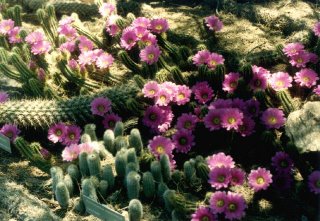 Even though a lot of people don't think of this shot as a typical Scottsdale shot, that is exactly where I got it from. I think of Scottsdale more as a place of BLING in the desert. Sort of like Palm Springs, California or Las Vegas, Nevada (without all of the casinos). But the reality is that I wanted to feel just a little WARMER right now.
Even though a lot of people don't think of this shot as a typical Scottsdale shot, that is exactly where I got it from. I think of Scottsdale more as a place of BLING in the desert. Sort of like Palm Springs, California or Las Vegas, Nevada (without all of the casinos). But the reality is that I wanted to feel just a little WARMER right now.What I really liked most about this shot were the desert cactus plants that were in bloom at the time. Also as a one time potential architectual student and big fan of Frank Lloyd Wright, I also enjoy the architectural influence that he gave to this and the surrounding desert cities especially Tempe and Phoenix.
In 1937, the internationally renowned architect Frank Lloyd Wright set up his "winter camp" at the foot of the McDowell Mountains, creating what is now known as Taliesin West. Scottsdale, and the rest of Phoenix, have seen a huge influence from Mr. Wright. Many buildings throughout the area were designed by the famous architect. Today, there is a Frank Lloyd Wright memorial in Northern Scottsdale.
But even before the Anglo settlement and the influences of Frank Lloyd Wright, Scottsdale was a Pima village known as Va ai Sva on, meaning "rotting hay." Some Pima remained in their original homes well into the 20th century. For example, until the late 1960s, there was a still-occupied traditional dwelling on the southeast corner of Indian Bend Rd. and Scottsdale Rd. By now, however, all Pima have either moved into modern homes within Scottsdale (mainly in South Scottsdale), to the Salt River Pima-Maricopa Indian Community, or elsewhere.
The Hohokam's truly unbelievable (and many do not believe it?) legacy was in their creation of more than 125 miles (200 km) of canals to provide water for their agricultural needs. The remnants of this ancient irrigation system were adapted and improved upon in 1868 by the first Anglo company to stake a claim in the Valley of the Sun, when Jack Swilling set up the Swilling Irrigation Canal Company.
Twenty years later Scottsdale's future would turn sharply upwards, when a U.S. Army Chaplain, Winfield Scott, paid the paltry sum of $2.50 an acre for a 640 acre stretch of land where the city is now located. Winfield's brother, George Washington Scott, was the first resident of the town that was then known as Orangedale and later changed to Scottsdale in 1894.
In 1951 the Town of Scottsdale was officially incorporated with a population of 2000. Since then it has grown to a 2004 Census estimate of 221,792. It has grown to become Arizona's fifth-largest city, and one of its most celebrated. Scottsdale is commonly defined by its high quality of life, and in 1993 was named the, "Most Livable City," in the United States by the United States Conference of Mayors. This title is notoriously lampooned across the state since the cost of living in Scottsdale is quite high.
Scottdale is continually ranked as one of the premier golf and resort destinations in the world, with a sizable portion of tax revenue being derived from tourism. It is also home to the FBR Open Golf Tournament held at the Tournament Players Club, which carries the distinction of the best-attended event on the PGA Tour. The city continues to see rapid growth, mainly in the northern areas of the city. It also brings with it many of the snow birds that flock here every winter to escape the cold weather in the East and Midwest.
Scottsdale is a satellite city of Phoenix in Maricopa County, Arizona, USA. Named by the New York Times as "The Beverly Hills of the Desert," Scottsdale has become internationally recognized as a premiere and posh tourist destination, while maintaining its own identity and culture as "The West's Most Western Town."
"If you wish to travel far and fast, travel light. Take off all your envies, jealousies, unforgiveness, selfishness and fears." -Glenn Clark












